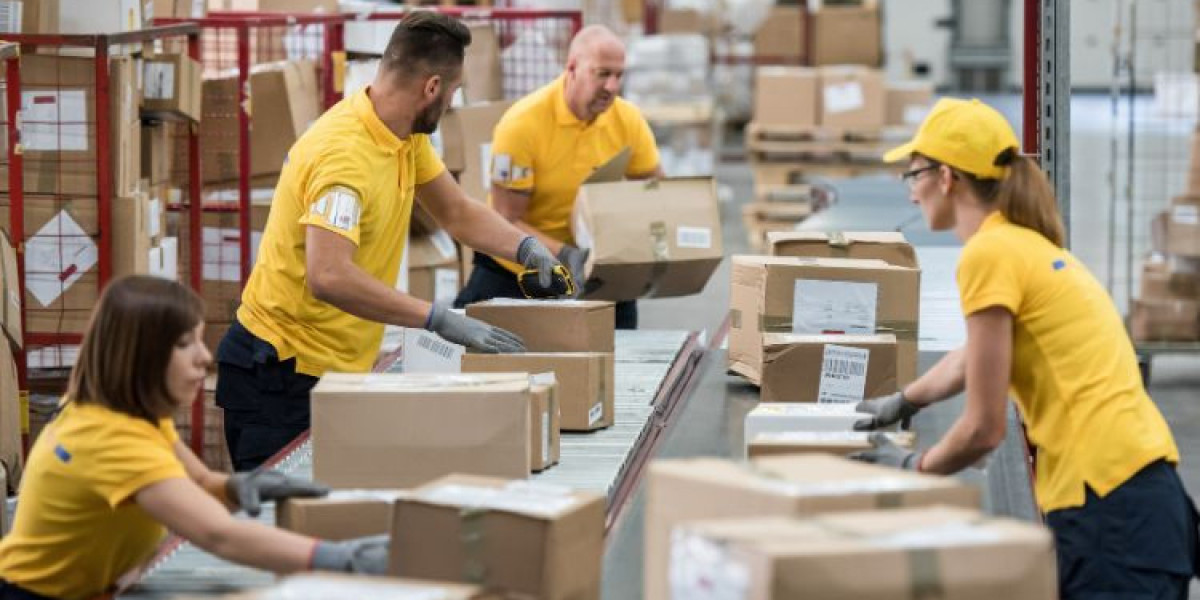The global postal packaging market size has experienced significant growth in recent years, driven by the booming e-commerce industry and increased demand for efficient shipping solutions. In 2023, the market size reached approximately USD 12.53 billion, and it is projected to continue its expansion at a CAGR of 6.20% between 2024 and 2032, ultimately reaching a value of USD 21.54 billion by 2032. While this growth is indicative of a thriving industry, it also raises concerns about the environmental impact of postal packaging waste.
In this blog post, we will delve into the critical issue of postal packaging waste and explore practical strategies to reduce it. The excessive use of packaging materials not only contributes to environmental degradation but also results in increased costs for businesses. By adopting greener shipping practices, companies can not only reduce their ecological footprint but also realize significant cost savings. So, let's embark on a journey to discover how to make our shipping processes more sustainable.
Understanding the Problem
- Discussing the Prevalence of Over-Packaging
One of the primary issues contributing to postal packaging waste is the prevalence of over-packaging. In a competitive e-commerce landscape, companies often use excessive materials to protect their products during transit, fearing damage or returns. This practice not only wastes resources but also leads to a surplus of packaging materials that end up in landfills.
The statistics are concerning. According to the Environmental Protection Agency (EPA), containers and packaging account for 30% of municipal solid waste in the United States. That's a substantial portion of waste that could be reduced through smarter packaging practices.
- The Environmental Consequences of Excess Packaging Materials
The environmental consequences of excessive postal packaging are far-reaching. First and foremost, it contributes to the depletion of natural resources. The production of cardboard and plastic materials involves the extraction of raw materials, energy consumption, and greenhouse gas emissions. Furthermore, the disposal of excess packaging materials in landfills or incineration facilities contributes to pollution and habitat destruction.
In addition, the transportation of larger and heavier packages results in higher fuel consumption and increased carbon emissions. This further exacerbates the negative impact of over-packaging on the environment.
- Economic Implications for Businesses
While over-packaging may seem like a protective measure, it comes at a cost to businesses. The excess materials used in packaging translate into higher expenses for purchasing, storing, and disposing of packaging materials. Moreover, larger and heavier packages incur higher shipping fees, which can significantly affect a company's bottom line, especially for businesses that ship a high volume of products.
In an era where sustainability is increasingly valued by consumers and investors, businesses that do not address their packaging waste may suffer reputational damage and lose out on potential customers. Moreover, government regulations and policies related to packaging waste are becoming more stringent, making it essential for companies to adopt eco-friendly practices.
Tips for Reducing Postal Packaging Waste
Now that we've established the importance of reducing postal packaging waste, let's explore practical tips and strategies to address this pressing issue.
- Optimize Packaging Size and Dimensions
A. Choosing the Right-Sized Boxes or Mailers
Selecting appropriately sized packaging is one of the most effective ways to reduce waste. Encourage your packaging team to use boxes and mailers that snugly fit the products being shipped. Oversized packaging not only wastes materials but also increases shipping costs due to volumetric weight calculations.
By right-sizing your packages, you not only reduce the use of materials but also ensure that items are securely packed, minimizing the risk of damage during transit.
B. Using Packaging Calculators or Software
Incorporate packaging calculators or software into your shipping process to determine the ideal box size for each order. These tools consider the dimensions and weight of the items, helping you select the most efficient packaging solution. Many major shipping carriers offer such tools on their websites, making it easy for businesses to make informed packaging decisions.
- Choose Eco-Friendly Packaging Materials
A. Discussing Alternatives like Recycled Cardboard, Biodegradable Options, and Reusable Materials
Eco-friendly packaging materials are a cornerstone of sustainable shipping practices. Consider alternatives such as recycled cardboard, biodegradable packaging, and reusable materials like fabric bags or containers. Recycled cardboard, in particular, reduces the demand for virgin materials and decreases energy consumption during production.
Biodegradable options, such as packaging made from cornstarch or mushroom mycelium, break down naturally, reducing the environmental impact of discarded packaging materials. Reusable packaging is an innovative solution that can significantly reduce waste if implemented correctly.
B. The Benefits of Using Eco-Friendly Materials
Highlight the advantages of using eco-friendly packaging materials. They not only align with your commitment to sustainability but also appeal to environmentally conscious consumers. Mention that using recycled or biodegradable materials can enhance your brand image and reputation.
Moreover, choosing eco-friendly options may help your business comply with regulations related to packaging waste and demonstrate corporate responsibility.
- Implement Efficient Packing Techniques
A. Properly Securing Items Without Excessive Cushioning
Efficient packing techniques are essential to reduce waste while ensuring that products arrive at their destination intact. Train your packing team to secure items within packages without excessive cushioning. Use protective materials such as bubble wrap or packing peanuts sparingly, and only when necessary to protect fragile items.
B. Reducing the Use of Plastic Wrap and Tape
Plastic wrap and tape are commonly used for sealing packages, but they contribute to plastic waste. Consider using alternatives like paper-based tape, which is recyclable and biodegradable. Additionally, explore self-sealing packaging options that eliminate the need for excess tape.
- Educate Employees and Partners
A. Training Staff on Responsible Packaging Practices
Education is crucial in implementing sustainable packaging practices. Conduct training sessions for your employees to raise awareness about the importance of reducing packaging waste and provide guidance on proper packaging techniques. Make sure they understand the environmental and financial benefits of these practices.
B. Collaborating with Suppliers to Reduce Excess Packaging
Collaborate with your suppliers to minimize excess packaging at the source. Encourage them to use eco-friendly materials and adopt responsible packaging practices when shipping products to your business. Building a partnership that prioritizes sustainability can lead to a reduction in unnecessary packaging materials.
Case Studies
Let's take a look at some real-life examples of businesses that have successfully reduced their postal packaging waste and reaped the benefits of more sustainable practices.
Case Study 1: Eco-Friendly E-commerce Giant
One notable example is a leading e-commerce company that transitioned to using biodegradable packaging materials for their shipments. By replacing traditional plastic mailers with biodegradable options, they reduced the environmental impact of their packaging waste. They also implemented a system that right-sized their boxes based on product dimensions, leading to a significant reduction in cardboard usage.
The results were impressive. The company not only reduced their carbon footprint but also saw a boost in customer loyalty. Customers appreciated the company's commitment to eco-friendly practices and were more likely to make repeat purchases.
Case Study 2: Sustainable Startup
Another inspiring story is that of a small startup that decided to prioritize sustainability from the beginning. They adopted reusable packaging for their products and encouraged customers to return the packaging for reuse. This approach not only minimized waste but also saved the company money on packaging materials.
The startup's commitment to sustainability resonated with their target audience, and they quickly gained a reputation for being an eco-conscious brand. This led to positive media coverage and increased sales, proving that sustainability can be a competitive advantage, even for new businesses.
Benefits of Greener Shipping
By now, you may be wondering about the tangible benefits of adopting greener shipping practices. Let's explore the advantages that businesses can gain from reducing postal packaging waste.
Enhanced Brand Reputation: Demonstrating a commitment to sustainability through eco-friendly packaging can significantly enhance your brand's reputation. Customers are increasingly conscious of the environmental impact of their purchases, and they appreciate businesses that take steps to reduce their ecological footprint.
Cost Savings: Sustainable packaging practices often lead to cost savings in the long run. By right-sizing packaging, using fewer materials, and reducing shipping fees, businesses can lower their expenses. Moreover, eco-friendly packaging materials may be more cost-effective than traditional options in the long term.
Compliance with Regulations: Governments and regulatory bodies are becoming more stringent regarding packaging waste and environmental impact. By adopting greener shipping practices, businesses can proactively comply with these regulations, avoiding potential fines and penalties.
Attracting Eco-Conscious Customers: Sustainable practices can help attract and retain eco-conscious customers who prioritize environmentally responsible brands. These customers are often willing to pay a premium for products and services that align with their values.
Positive Environmental Impact: Perhaps the most important benefit is the positive impact on the environment. By reducing packaging waste, businesses contribute to less pollution, resource depletion, and carbon emissions. This helps preserve natural resources and combat climate change.
Read More
https://www.expertmarketresearch.com/articles/top-automotive-airbag-inflator-manufacturers
Challenges and Solutions
While the benefits of reducing postal packaging waste are clear, there are challenges that businesses may face when implementing greener shipping practices. Let's examine these challenges and explore potential solutions.
Challenge 1: Resistance to Change
Solution: To address resistance to change within your organization, it's crucial to provide education and training. Help employees understand the environmental and financial benefits of sustainable packaging practices. Additionally, involve them in the decision-making process and gather feedback to make the transition smoother.
Challenge 2: Balancing Sustainability with Product Protection
Solution: It's essential to strike a balance between sustainability and product protection. Conduct thorough testing to ensure that your new packaging materials and techniques adequately protect your products during transit. If necessary, collaborate with packaging experts to find innovative solutions that meet both objectives.
Challenge 3: Supplier Cooperation
Solution: Collaborate with your suppliers to encourage responsible packaging practices. Clearly communicate your sustainability goals and work together to find eco-friendly solutions. Consider establishing long-term partnerships with suppliers who share your commitment to sustainability.
Challenge 4: Meeting Customer Expectations
Solution: Addressing customer expectations is crucial. Clearly communicate your sustainable packaging initiatives to your customers, highlighting the positive impact of their choices. Consider offering incentives for customers who choose eco-friendly packaging options or participate in recycling programs.
Conclusion
The global postal packaging market is on a growth trajectory, with its value projected to reach USD 21.54 billion by 2032. While this growth is promising, it brings with it the challenge of increased postal packaging waste. Excessive packaging not only harms the environment but also impacts businesses' bottom lines.
However, there is hope. By adopting greener shipping practices, businesses can reduce their ecological footprint, cut costs, enhance their brand reputation, and attract eco-conscious customers. The journey to a more sustainable shipping process begins with optimizing packaging size, choosing eco-friendly materials, implementing efficient packing techniques, and educating employees and partners.
Case studies demonstrate that companies of all sizes can successfully reduce postal packaging waste and benefit from their sustainability efforts. Challenges such as resistance to change, product protection concerns, and supplier cooperation can be overcome with the right strategies and commitment to sustainability.
In a world where environmental responsibility is increasingly important, businesses have an opportunity to lead the way in reducing postal packaging waste. By doing so, they not only contribute to a greener planet but also position themselves for long-term success in an evolving marketplace. It's time for businesses to take action and make postal packaging more sustainable for a better future.










